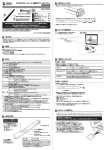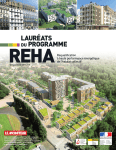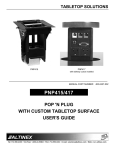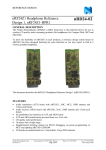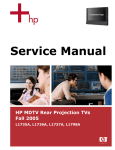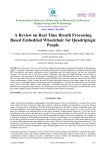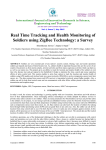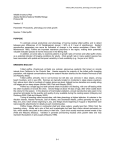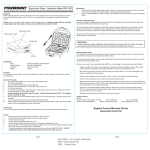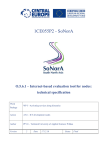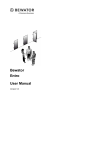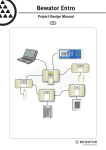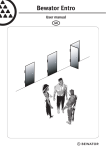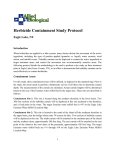Download June 06 - Nordic Semiconductor
Transcript
www.nordicsemi.no JUNE 06 THE WIRELESS QUARTER In this issue u Desktop PC speakers DAB RADIO SPEAKER Asono selects nRF24Z1 to deliver wireless audio to its DAB radio } p Svenn-Tore Larsen u South China Morning Post interview u nRF24Z1 headphone reference design u Nordic in the press p People & faces Digital audio equipment manufacturer Asono has selected the Nordic Semiconductor nRF24Z1 transceiver to power a wireless link between its DAB1 “kitchen shelf” radio and remote stereo speaker to guarantee market-leading audio quality and reduce power consumption. Users simply insert an SD (Secure Digital) memory-sized card supporting the nRF24Z1 transceiver and its supporting electronics into the back of the DAB1 radio to enjoy high quality sound from the stereo speaker at up to 10 m from the main unit. “We knew the DAB1 would have to stand out when auditioned alongside strong existing competition,” comments Lars Elstad, marketing manager at Asono. “In addition to including leading design features – such as a digital display that can be re-orientated when a user turns the main unit on its side, and the ability to pause, rewind and record DAB radio broadcasts – it had to sound great.” “The challenge with achieving high-fidelity sound quality was that we wanted to include a wireless speaker option for customers who desired the convenience, but we did not want to lose any sound quality compared to a wired speaker connection,” adds Mads Hoyby, Asono product developer. “Because we specified high quality speakers from Norwegian manufacturer SEAS, differences “Our engineers were surprised at just how good the nRF24Z1 transceiver sounded when streaming wireless audio to our speakers in the Asono DAB radio” in audio quality were easily detectable due to faithful reproduction of the source audio signal. In addition, although the satellite speaker is mainspowered, the main unit can be battery powered, so low power consumption is essential. “We initially tried a Bluetoothbased solution for the wireless link, but found that the power consumption was high. The wireless audio link was also more prone to ambient 2.4 GHz interference than Nordic’s transceiver. And, perhaps most importantly, the Nordic solution sounded noticeably better.” This finding is echoed by specialist Norwegian hi-fi speaker design and manufacturing firm SEAS. “Our engineers were surprised at just how good the nRF24Z1 transceiver sounded when streaming wireless audio to our speakers in the Asono DAB radio,” comments Jørgen Gjerdrum, SEAS sales and marketing director. “To our ears the Nordic transceiver lost practically nothing in terms of outright sound quality compared to a conventional hard-wired connection. We didn’t think that was yet possible with any wireless audio streaming transceiver, let alone a low cost, volume part like the nRF24Z1.” The nRF24Z1 transceiver boasts ample bandwidth (up to 4 Mbit/s) to deliver uncompressed 16-bit resolution, 44.1 kHz, CD quality audio per channel in any wireless audio application. WELCOME TO THE WIRELESS QUARTER This is the first issue of Nordic’s new quarterly newsletter. It is designed to keep you updated on the latest news and developments at Nordic and is supplied free-of-charge. Next issue out September 06. PLEASE FORWARD THIS NEWSLETTER TO ANY COLLEAGUES OR CUSTOMERS WHO MAY FIND IT USEFUL To subscribe (or un-subscribe) please e-mail: [email protected] www.nordicsemi.no SOUTH CHINA MORNING POST “We have been particularly successful in making breakthroughs into several new market segments.” Svenn-Tore Larsen Dear Reader, Welcome to Nordic Semiconductor’s first newsletter for 2006. These are exciting times for the company. The work we have put into strengthening our sales operations – for example, opening a Korean office and adding a new distributor in Asia and the US – and merging our component development departments, plus investing significantly in equipment such as new chip testers, is bearing fruit. It won’t be too long before millions of consumer products enabled by our RF chips are available in stores across the globe. We have designed this newsletter to emphasise our mission to become the leading supplier of RF products in our chosen market sectors. It’s contemporary in design, incisively written and focuses on the characteristics of our products that make them so successful – lowpower, simple to design-in, low–cost and high-performance. I have recently completed my column for Nordic’s 2005 Annual Report. In it I commented how we have been particularly successful in making breakthroughs into several new market segments. We have won major contracts with manufacturers of intelligent sports equipment, PC peripherals (mouse and keyboard) and audio. In these pages you can find short forms of press releases and articles we have had published in the leading business-to-business magazines and newspapers round the world. These articles include in-depth discussions as to why our products are so well suited to many different applications. For example, the nRF24Z1 audio streamer is making significant impact for devices demanding near CD-quality audio such as wireless headphones for portable music players. Our front cover story, for example, details a great success in the Asono DAB radio and remote stereo speaker pairing. Later in these pages there’s an application note describing a reference kit that makes designing with the nRF24Z1 even simpler. Looking forward, we are excited about the prospects for our products in meeting consumers’ demands for a radio interface between mobile phones and other portable electronic equipment. We believe this telecommunications application will make a significant contribution next year. Of course, none of this would be possible without the support of our customers. The products we make are directly influenced by your feedback for which I thank you. Please continue to offer your thoughts and do let me know if you like this newsletter. Yours sincerely, Svenn-Tore Larsen Chief Executive Officer 2 NORDIC WIRELESS QUARTER JUNE 2006 Nordic grows electronics business in China In April, Nordic’s CEO, Svenn-Tore Larsen and Sales & Marketing Director, Geir Langeland, talked to journalists from Discovery Report, a supplement of the South China Morning Post, about the company’s activities in China. This is an excerpt from that interview } At a time when many Western companies are entering China to manufacture goods for export, Nordic is supplying semiconductor chips for wireless technology to the Chinese consumer electronics industry. “Our revenue stream is moving in the opposite direction from most companies,” says Geir Langeland, Nordic’s Director of Sales and Marketing. More than 60 per cent of Nordic’s revenues come from its China operation. Its superior technology, coupled with topnotch sales support, has won over big clients like Lenovo. The Chinese computer maker is using Nordic products to create a wireless link between its PCs and desktop speakers. Nordic first entered the mainland market six years ago and found initial success in remote monitoring devices for water and electric meters. Today, it sees great potential in wireless audio electronics. Such innovations are the result of Nordic’s significant research and development efforts. The company’s R&D centre in Trondheim, Norway, employs 45 highly qualified and talented engineers. The company has enjoyed long and stable relationships with its partners in China. Nordic works on an independent sales organisation model, in which local partners handle all sales. Ever since it entered the Chinese market, Nordic has been involved with a university-founded company called XunTong. “Because it’s an offspring of a university, it’s tremendously good at technology,” says Svenn-Tore Larsen, Nordic’s Chief Executive Officer. “It also has strong government connections and is extremely eager to make money. These components have made us successful with XunTong.” Nordic needs local support across China because the country is changing so quickly. “Design centres have traditionally been in Shenzhen, Beijing and Shanghai,” says Geir Langeland. “But now they’re moving out in the regions and we need to follow them there.” Local representation is extremely important to Nordic. “For us, having the right partner is like a marriage,” says Langeland. “When they get to know us, they are open and give us feedback on ways to improve. If you have a very pure business relationship it’s not as easy to give important feedback.” Nordic distributors are valuable in other ways too. They are technically very knowledgeable, enabling them to train clients how to integrate Nordic chips to add wireless links to their products. That shortens the customers’ design cycles, saving them time and money. But service doesn’t end there. Nordic’s field application engineers work with customers after sales to overcome any difficulties with the product. China is growing so fast that Nordic is now recruiting more Chinese field application engineers. “It’s important for us to have strong engineering support from the day our customers decide to use a Nordic product until it’s in production,” says Svenn-Tore Larsen. Nordic’s vision is to build the business even further in China. “We are in China to become one of the leaders in the wireless and audio segments that will come out of the explosive growth in the country. I want it to be a huge chunk of our business in the next 10 years,” says Larsen. NEWS DESKTOP PC SPEAKERS IN BRIEF Lenovo wireless desktop PC speakers use nRF24Z1 to deliver CD-quality sound } Lenovo has developed the world’s first wireless desktop PC speaker application to offer full, uncompressed CD quality audio by using the Nordic nRF24Z1. This means 16-bit sampling resolution per channel at 44.1 kHz across a 4 Mbit/s data stream. The nRF24Z1 is the world's first 2.4 GHz transceiver to provide genuine CD sound quality wireless audio streaming. In addition, it exhibits extremely low latency and the usual Nordic hallmark of ultra low power consumption. This makes the nRF24Z1 ideal for producing high quality audio and extending battery life in portable devices. “Lenovo has systematically worked extremely hard with Nordic Semiconductor to develop and bring to market the first wireless Desktop PC speaker application in the form of the LXH-J5146MWTM,” says Jun Ouyang, Director, Product Development, Desktop Development, Lenovo China. “[The nRF24Z1’s] high performance, ease-of-use and low system cost, allied with the fact it requires no audio compression, set the foundation that enabled us to reach this significant goal.” “Lenovo’s goal of being the first-to-market with the LXH-J5146MWTM has been a significant challenge for Nordic and for Lenovo,” adds Nordic CEO Svenn-Tore Larsen. “But by partnering together we were able to solve the technical challenges and we are extremely satisfied Nordic Semiconductor and Nu Horizons Electronics Corporation have extended their existing panAsian distribution agreement to include the United States, Canada and Mexico. The agreement covers Nordic’s entire product range. “We look forward to collaborating with Nordic to distribute technologically advanced products that mutually strengthen our global reach, and to extending our seamless customer support,” comments Dave Bowers, president of Nu Horizons Distribution Division. that the development has been a great success for both parties.” ABOUT LENOVO Lenovo is an innovative, international technology company formed as a result of the acquisition by the Lenovo Group of the IBM Personal Computing Division in May 2005. As a global leader in the PC market, Lenovo develops, manufactures and markets cutting-edge, reliable, high-quality PC products and value-added professional services that provide customers around the world with smarter ways to be productive and competitive. The company says it bases its success on helping customers to achieve their goals in terms of productivity in business and personal life enhancement at home. PC CONTROLLER & LASER PRESENTER Raytac selects nRF24xx chipsets to deliver low power, omni-directional wireless control } Raytac Corporation has selected the nRF2402 and nRF2401A, 2.4 GHz RF-chipsets for its latest PP2400 PCMCIA form factor, combined wireless controller and laser presenter. The PP2400’s profile allows it to be conveniently stored in a standard PCMCIA port on a notebook PC when not in use. The Raytac PP2400 is the first product of its type to offer omnidirectional wireless control at indoor ranges of up to 30 meters between laptop and user. The user simply inserts a USB receiver into the laptop and the plug-andplay product is ready to use. No additional software is required. Distribution partnership expands to North America “The compact packaging of the nRF24xx and low external component count enabled us to achieve the ultra slim PCMCIA form factor of the PP2400,” says Afu Chang, Managing Director of Raytac Corporation. “In addition, Nordic’s proven expertise in both low power wireless and reliable product performance - including robust interference resistance from other 2.4 GHz devices operating in the vicinity - clearly made the nRF24xx the optimum solution on the market today for such a low power, cost critical, volume consumer product.” “Raytac continues to be a focus partner for Nordic Semiconductor in the PC peripheral application market,” adds Chim Chan, Chinese Area Sales Manager at Nordic Semiconductor. “The PP2400 builds on the wide range of previous Raytac 2.4 GHz wireless communication applications where Nordic technology has been selected because it is the market leading solution.” Joint white paper with Philips now available A white paper describing how to interface the Philips PLN2020 twin-eye laser sensor to the Nordic Semiconductor nRF24L01 2.4 GHz transceiver is now available to download from the Nordic website. The low power Philips laser leverages the latest developments in solid-state lasers, digital signal processing and System in Package (SiP) technology to achieve ultra high resolution and accuracy for position/velocity sensing in consumer product applications. ASIC is intelligent and sporty Nordic Semiconductor has successfully developed an ASIC for Polar Electro Oy’s intelligent sports equipment platform. “Nordic has competence in designing IC's for very low power and space limited applications. Cooperation with Nordic helps us to maintain our market leadership in sports instruments and heart rate monitoring equipment,” says Janne Klemetti, IC-Design Manager, Polar Electro Oy. NORDIC WIRELESS QUARTER JUNE 2006 3 www.nordicsemi.no WIRELESS HEADPHONES nRF24Z1 headphone reference design for CD quality audio streaming Nordic Semiconductor’s nRF24Z1 is the ideal transceiver for linking wireless headphones to portable music players. Nordic has now released a headphone reference design to demonstrate the feasibility of the nRF24Z1 in this application T he Nordic Semiconductor nRF24Z1 single-chip 2.4 GHz, RF transceiver is a wireless CD quality audio streaming device suitable for headphones communicating with CD-, MP3- and Mini Disk-players. The nRF24Z1 maintains 4 Mbit/s bandwidth to stream true “lossless” digital audio. The nRF24Z1 uses adaptive frequency hopping to avoid clashes with other devices operating in the 2.4 GHz band. The chip is manufactured using low-cost 0.18 µm CMOS fabrication, and is supplied in a 36-pin, 6 by 6-mm QFN package. Nordic has produced a reference kit for design engineers featuring functionality similar to that of proprietary wireless headphones. The reference kit demonstrates the feasibility of the nRF24Z1 in music players and provides comprehensive guidance for the implementation of a nRF24Z1-based design. The hardware and published design files aid customers who want to design their own products based on the nRF24Z1. The design files need only small alterations (for example, to the printed circuit board (PCB) form factor and placement of the user interface buttons on the PCB) to convert them to production-ready files. The reference design comprises an audio transmitter (ATX) PCB, an audio receiver (ARX) PCB and a daughterboard used for insystem programming and debugging. The system is controlled by a microcontroller (MCU) on the ATX board. Both the ATX and ARX PCBs feature a user interface comprising six push buttons and an LED. The user interface can be easily modified. In this application note we consider how to avoid crosstalk, positioning and impedance matching of the antennas for optimum reception and reliable pairing. Avoiding crosstalk The nRF24Z1 is a radio transceiver using packet-based transmission. Consequently, 4 NORDIC WIRELESS QUARTER JUNE 2006 the chip will constantly toggle between transmit and receive modes. The current draw in each mode is different and this can give rise to a voltage ripple on the power supply. If the ripple transfers to the analogue audio element of the design (i.e. the ADC, DAC and CODEC devices), a persistent 250-430 Hz hum will be heard through the earphones. To avoid this contamination, when the nRF24Z1 is used in combination with ADC, DAC and CODECs it must be considered part of the digital element. It is very important to avoid power supply noise generated by the nRF24Z1 (and other digital circuitry) from reaching the analogue supply pins and reference voltage pins of the ADC, DAC and CODEC. Star-routing directly from a low-noise supply source (for example, a linear voltage regulator) is highly recommended. The nRF24Z1 should have its own power supply line from the supply source. The ADC, DAC and CODEC should also have their own separate digital and analogue supply lines. In some designs an LC filter (comprising serial inductor and shunt capacitor) on the analogue supply line to the ADC, DAC and CODEC could also be required. A power supply distribution strategy based on star-routing from a linear voltage regulator with supply decoupling for the nRF24Z1, ADC and DAC devices has been implemented on the ATX and ARX boards of the reference design. This includes a power supply distribution strategy, supply decoupling, PCB layout and other important design issues for the nRF24Z1, plus the illustrated use of a Wolfson Microelectronics ADC (WM8951L) and DAC (WM8711L) in accordance with the relevant datasheets for each device. Good ground layout is just as important as the power supply distribution strategy to ensure the best possible performance both from the nRF24Z1 and the ADC and DACs. The ATX and ARX PCBs use a two-layer board and available areas of each layer are covered in the ground plane. The ground planes of each layer are connected by via holes. Nordic Semiconductor’s nRF24Z1 Headphone Reference Design Antenna design The ATX and ARX PCBs use a Fractus FR05-S1-N-0-102 chip SMD antenna. The antenna has been positioned according to the recommendations given in the Fractus antenna User Manual and application note “Wireless Headsets” (document AN_FR05-S1N-0-102). These documents are available on request from Fractus (www.fractus.com). Environmental factors such as the shape of the PCB, area of ground plane, proximity to housing, housing material and proximity to the user can affect the antenna impedance matching and radiation properties. Changing one or more of these parameters in an application will change the antenna impedance and may require re-matching the antenna and receiver for good performance. When designing with Nordic’s nRF devices, the initial antenna impedance matching should be based on the standard 50 Ω matching network described in the nRF device Product Specification. The antenna impedance is measured with the antenna placed in its normal position and with the application operating in its natural environment. If the measured antenna impedance deviates significantly from 50 Ω, extra matching components must be added in between the standard 50 Ω matching network and the antenna input to make the antenna act as a 50 Ω load. In most cases antenna impedance can be matched by adding a PI network (i.e. shunt C or L - series C or L – shunt C or L) in between Nordic’s standard 50 Ω matching network and the antenna input. Vector network analyzers are widely used for antenna impedance and Voltage Standing Wave Ratio (VSWR) measurements. After establishing the impedance value, the graphical aid method of Smith chart is an effective way of designing the added impedance matching network. The reference design ATX and ARX boards use a 1.5 pF shunt capacitor to ground. This was needed for optimal impedance matching of the Fractus antenna when operating in the 2.4 GHz band. Figure 1 shows the ATX board measured antenna radiation patterns with horizontal and vertical polarization. Often, practical designs produce radiation patterns that aren’t omni-directional and this is the case with the reference design. Consequently, great care must be taken when placing the antenna in a headphone design to ensure that ATX and ARX PCB antennas point towards each other in most user situations. Therefore follow the antenna manufacturers guidelines closely when placing the antenna and additional matching circuitry. Figure 1 (a) and (b) ATX board, antenna radiation patterns Reliable pairing Both the ATX and ARX PCBs have six push buttons and one power on/off switch. While for simplicity the reference design’s ATX and ARX PCBs each use two AAA batteries and a hard On/Off switch, a typical application would consist of a rechargeable battery and charging electronics with a soft power On button. There are three different ways to implement a soft power On button when using the nRF24Z1. These options are: Soft power On on the ATX PCB only; soft power On on the ARX PCB only, and soft power On on both boards. The third option consumes more battery power than the other options. Much of the reference design depends on this choice. When the boards are powered up they broadcast on an initial address. This address must be chosen carefully so that it is not compatible with a competitor’s product. Once the ATX and ARX are both switched on and the user presses and holds the Play button, the ATX will generate a random private address for both devices for the time the power is on. This means that at power up, any ATX may pair with any ARX within a product family. (A product family is made up of ATX and ARX devices that all share a common initial broadcast address, DAC chip, buttons definition and power saving scheme.) After one set of ATX and ARX has paired on a private address, other devices in the same area may be paired too. If the ATX pairs with an unwanted device, switching both ATX and ARX off and back on will result in a new pairing. The reference design uses dynamic pairing at every power up. Consequently, if battery Off is selected on one device, battery Off must also be selected on the other in order for them to pair again. This is because if devices are paired and then one is turned off the other will retain the private address and not return to broadcasting the initial address before it is switched off and then back on. The reference design uses this methodology because it is impossible to detect if loss of signal is due to the partner being turned off or being moved temporarily out of range. It is possible to add a reset button to the nRF24Z1 that will have the same effect on the device as power cycling. However, this has not been implemented on the reference design. The nRF24Z1 reference kit comprises: · Reference design audio transmitter (ATX) PCB; · · · · · Reference design audio receiver (ARX) PCB; A daughterboard used for in-system programming and debugging; Flat flexible cable (FFC) with connector; Nordic’s “EEPROM programmer USB dongle”; USB cable. FURTHER INFORMATION: Full technical details of the reference design are available in the paper entitled “nRF24Z1 Headphone Reference Design 1, nRF24Z1-HPR1” downloadable from www.nordicsemi.no APPLICATION NOTE NORDIC WIRELESS QUARTER JUNE 2006 5 www.nordicsemi.no ELECTRONICS WEEKLY Battery power gets the Bluetooth blues The full version of this article was originally published in the 8 March issue of Electronics Weekly (EW). EW is the UK’s premier electronics newspaper with a registered circulation of 26,700 qualified subscribers A proprietary alternative to Bluetooth extends sports watch battery life, says Nordic Semiconductor application engineer, Jon Gunnar Sponås S hort-range, relatively low speed wireless communications in consumer electronics have become almost synonymous with IEEE 802.15 (Bluetooth). Yet while Bluetooth certainly helps simplify the incorporation of wireless comms into a vast range of applications – including wireless comms between a PDA, headset, mobile phone and laptop PC – it’s not without drawbacks. These are particularly evident for “power and cost critical” battery applications such as wireless mice, keyboards, joysticks, intelligent sports equipment (e.g. watches), and toys. The underlying reason is that Bluetooth’s strength – the ability to form and manage an ad-hoc “piconet” of up to eight devices (one master and seven slaves) – turns out to be a weakness in point-to-point battery-powered applications. The master determines the 1600 frequencies to be used each second across the nominal 2.4 GHz band. In operation, the master sends a 160-bit packet every 675 µs (1600 packets/s, or a net data rate of 256 kbit/s) to maintain the link, whether the target device is in use or not. This synchronization scheme was developed to avoid the inevitable clashes that would occur in a piconet if the master were to randomly transmit to the slaves. And even though the IEEE802.15 standard does provide for missed or corrupted packets to be resent, this further compromises the data transfer rate and power consumption. The reality is that while synchronization is a distinct advantage for maintaining data transmission when several devices are communicating over a single piconet, it’s a real drawback in point-to-point applications. The simplicity of these applications doesn’t demand the forced synchronization of the Bluetooth standard. As a result, the link is slowed unnecessarily by synchronization packets, and the transmitter uses more power due to the increased duty cycle. The nRF24L01, 2.4 GHz integrated transceiver from Nordic Semiconductor, for example, consumes up to 75 percent less power than comparable Bluetooth devices in typical point-to-point applications (1.9 to 3.6 V supply). It also offers a maximum air data rate of 2 Mbit/s compared to Bluetooth’s nominal 1 Mbit/s in its lowest power mode. A proportion of this power economy comes from employing a more efficient data packet overhead, as well as a data payload up to 8x larger than Bluetooth’s. The packet structure comprises 8-bit preamble, 40-bit address, up to 256-bit payload and 8/16-bit CRC (cyclic redundancy check). This can be used to perform a message transfer in 256 bits, yielding an overhead of 56 bits, and giving a raw packet data-efficiency of 82 percent. Intelligent sports watch example Let’s contrast Bluetooth with the nRF24L01 in a sports watch designed to monitor and record data from a wireless pulse rate monitor in contact with the user’s wrist or chest. A typical usage pattern is 10 percent active and 90 percent sleep, with a communications cycle of transmission and reception every 500 ms of operation when in the active part of the duty cycle. Given a 32bit payload, the proprietary packet length will still be around half that of a Bluetooth packet (88 versus 160 bit). The sequence diagram for the proprietary design shows that the heart rate part of device is active for 130 + 64 + 130 + 24 = 348 µs, and the wristwatch part of the device for 130 + 64 + 130 + 24 +130 + 64 = 542 µs. For the typical 500-ms communications cycle this gives an actual duty cycle of 1:922. Because the active time during the 500-ms communications cycle is relatively low, the average current consumption when in “constant” use is 13 µA. (This is lower then the standby current because between packets the transceiver is put into the 400- nA powerdown mode.) Although Bluetooth also has an average current consumption of 45 mA when active, it continues to run at 15 mA in “idle” mode to maintain synchronization. This means the current consumption is dominated by the RF part. Given that a typical 3.0-V lithium coin cell can deliver no more than 20 mA maximum, a Bluetooth-based design would require AAA battery in both the watch and pulse sensor, adding significant bulk and weight to the application. The bottom line is that Bluetooth has proven to be a very successful way to build wireless connectivity into devices such as cell phones where short duty cycles and universal compatibility are the norm. And adhering to the IEEE standard certainly eliminates much of the design challenge. But for many portable applications with low duty cycles, Bluetooth can be far more demanding of the batteries than alternative approaches. TO SEE ORIGINAL ARTICLE GO TO: www.electronicsweekly.com/Articles/2006/03/09/37868/BatterypowergetstheBluetoothBlues.htm 6 NORDIC WIRELESS QUARTER JUNE 2006 PRESS ARTICLES WIRELESS DESIGN & DEVELOPMENT ASIA The fine art of wireless sound for portable music Bluetooth is king for wireless personal area networks, but it may not be the best for niche applications such as wireless audio transfer, explains Nordic’s Børge Strand The full version of this article was originally published in the January issue of Wireless Design & Development Asia. This is a sister title to EDN Asia and is circulated to 10,000 wireless specialists across Asia. A strong desire from consumers to personalize their MP3 players has also spawned a huge accessories sector. These users – familiar with using RF links to connect mobiles to earpieces – are now asking for a similar wireless headphone capability from their MP3 players. Notably, none of the major firms in the MP3 market is yet to introduce a wireless-enabled player, opening a market niche for others. At first glance, a simple solution awaits. Why not take one of the many competent Bluetooth 1.2 (BT 1.2) chipsets on the market and integrate it into a wireless MP3/ headphone player combination? Unfortunately, while Bluetooth’s nominal 1 Mbit/s data transfer rate is acceptable for a phone link, it doesn’t have the bandwidth required for CD-quality audio – vital for a satisfying user experience. In addition, Bluetooth’s relatively complex packet structure – a pre-requisite for ensuring compatibility – makes heavy processing and synchronization demands, quickly draining batteries. Fortunately, Bluetooth is not the only wireless technology around. For niche applications such as relaying CD-quality audio from an MP3 player to a headset, specialist designs are commercially available. Nordic Semiconductor manufactures an RF chipset designed for audio streaming. Dubbed the nRF24Z1, it is rated at 4 Mbit/s yet consumes power at half the rate of a comparable BT 1.2 chipset. The wireless connection is based on an RF chip using the 2.4 GHz ISM band. The audio link needs to include a frequency-hopping scheme that is robust enough to cope with potential interference from other 2.4 GHz ISM band traffic. Nordic’s nRF24Z1 transceiver has been specifically designed to transfer uncompressed CD-quality audio across a wireless link. The device has ample overhead to transfer 16-bit stereo samples at 48 kHz, a total data rate of 1.54 Mbit/s, and sufficient bandwidth for CD-quality. Power to the people Let’s look more closely at the power budget of our MP3-to-headphone CD-quality audio wireless link. Battery life is important to portable MP3 player users, who expect to be able to listen to audio on the move for extended periods. A transmitting or receiving BT 1.2 audio chip runs at around 60 mA current consumption. Consequently, operating at 2 V, the device draws 120 mW. Assuming the power source is a Li-ion battery operating at 3.7 V via a DC-to-DC converter of 90 percent efficiency, the power draw from the battery is 133 mW. The headphone mounted DAC/amp draws around 4 mA in operation. Assuming the DAC/amp runs directly from the battery voltage of 3.7 V it will draw 14.8 mW. A typical 3.7 V Li-ion battery has a capacity of 900 mAh, supplying 3330 mWh. With a total power consumption of 147.8 mW during playback, the user can expect 3330 mWh/147.8 mW = 22.5 hours of battery life. An RF link using the proprietary solution comprises an audio receiver (ARX) and an audio transmitter (ATX). Average ARX current is 22.9 mA while average ATX current is 17.8 mA. These figures are while transmitting and receiving a 44.1 kHz sampled, 16-bit audio stream without compression with a good radio link. Running at 2 V (the same as the Bluetooth device) the proprietary solution draws 45.8 mW from the DC-to-DC converter, requiring 50.9 mW from the battery. Adding the DAC/ amp consumption yields 65.7 mW. Using the 3.7 V Li-ion battery, the user now gets 3330 mWh/65.7 mW = 50.7 hours of battery lifetime, more than double the 22.5 hours experienced with the Bluetooth chip. CD digital audio samples the original analogue music signal at 44.1 kHz with 16-bit resolution for each channel. This sampling rate and resolution generates a data stream of 1.41 Mbit/s. BT 1.2 features a 1 Mbit/s nominal data rate that runs at around a 720 kbit/s in practice. While this data rate is sufficient to provide an acceptable audio stream, it certainly isn’t CD-quality and sounds poor in comparison. The comparison between BT 1.2 and the proprietary solution illustrates that it consumes less power transmitting CD-quality audio than Bluetooth does transmitting at a lower fidelity 720 kbit/s rate. That means using the proprietary solution could endow your design with both longer battery life and higher audio quality. These are significant assets in the fiercely competitive MP3 player marketplace. TO SEE THE ORIGINAL ARTICLE GO TO: www.wirelessdesignasia.com/article.asp?id=1345 NORDIC WIRELESS QUARTER JUNE 2006 7 www.nordicsemi.no THE PEOPLE & FACES Behind Nordic Semiconductor Steinar Os Field Applications Engineer Hi. My name is Steinar Os and I’m a Field Applications Engineer based at the Skøyen office in Oslo. I support customers all round the world and have worked in this role ever since I joined Nordic Semiconductor in February 2005. My job encompasses technical sales, technical support of our RF standard components, and ensuring feedback from our customers gets forwarded to the right people within our organization. What I really like about my job is all the great people I get to meet when I am out traveling to see customers. I also like the variety – every day is different. It never ceases to amaze me where our customers are planning to use our technology next. Most of the time the implementation of Nordic devices only requires initial advice on general RF design. This might include, for instance, routing and placement of other components and sometimes helping to optimize the antenna layout to get the best performance. Of course, from time to time we also face major technical and physical challenges when trying to put yet another IC onto an already fully crowded PCB. But no matter how challenging the situation we seem to face, I know I can always rely on the dedicated resources and brilliant expertise of our application R&D engineering team based at our company’s headquarters in Trondheim here in Norway. By working closely with our design engineers in Trondheim and the customer’s own design development team, we always manage to find a viable solution. Helping customers is most definitely a team task at Nordic. After identifying and getting the overview of a potential problem, Nordic’s response would be either to remotely support a customer, sending out resources to the customer onsite, or to invite the customer’s development team to work with our engineers and RF designers in Trondheim. Feedback and cooperation from customers is key for Nordic in order to prepare our future products for the demands in the market. Although Norway is a fast developing country, there still aren’t many job opportunities that would allow you to travel, meet with different cultures and visit exciting places around the world. This is why I really enjoy my job. However, I also appreciate my leisure time and spending time with my friends and family when I’m not working. And if you’re not from Norway, Norway is definitely a country you should visit if you get a chance. The nature is wild and dramatic and offers great skiing and hiking experiences to be found nowhere else. Steinar Os “By working closely with our design engineers in Trondheim and the customer’s own design development team, we always manage to find a viable solution” Øystein Pedersen Project Manager, nRF24L01 Hi. My name’s Øystein Pedersen and I’m a Project Manager based in Trondheim working on the development of our Standard Components. I’ve been working with Nordic Semiconductor since January 1997. My first job was as an RF design engineer, I then moved into project management around five years ago. One of the things that really inspires me in my job is the process by which we solve problems and develop new product solutions and features here at Nordic – both internally and with external customers. It’s hard to explain, but it’s a case of the whole becoming greater than the sum of its parts – and comes from working with a close knit, like-minded team of 20 or 30 people with totally different skill sets. In fact there’s a reason why Nordic’s standard products are so far ahead of our competition in terms of performance, cost and power consumption – it’s because we work so hard to make them that way. Often by making the “impossible” possible. For example, some of the initial technical challenges we face are so big that nobody could hope to solve them working on their own. We have to brainstorm new ideas in a completely open-minded and non-critical atmosphere where in the early stages no suggestion is “too crazy” or “stupid” or “mad”. You just don’t know where the solution is going to come from. But you do know that you have a world-class project team with a track record of developing world class products and that if anyone can find a viable solution to a problem, they can. I also think it’s important to credit part of our success to Svenn-Tore. He was the man that really boosted the wireless products by backing our department financially. That was the point that things really moved forward. Although I find my work immensely rewarding, it can be very draining emotionally and I find it’s important for me to relax outside of work doing different and contrasting activities. In the summer this usually means playing golf as much as I can, and in the winter snowboarding. I also love cooking – even though I’m not very good it: I have tried to make the perfect Chocolate Pavlova cake at least 20 times now without success. But when I do succeed my Trondheim team will be the first to benefit as I intend bring it into to work to share. Øystein Pedersen “I also think it’s important to credit part of our success to Svenn-Tore. He was the man that really boosted the wireless products by backing our department financially” PLEASE FORWARD THIS NEWSLETTER TO ANY COLLEAGUES OR CUSTOMERS WHO MAY FIND IT USEFUL To subscribe (or un-subscribe) please e-mail: [email protected]








